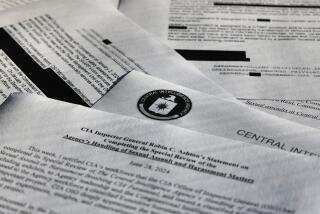Senate report says CIA torture methods yielded no useful intelligence

Reporting From Washington â The CIAâs brutal interrogations of terrorism suspects from 2002 to 2008 led to false confessions and fabricated information, produced no useful intelligence about imminent terrorist attacks and were so badly run that the CIA lost track of captives, according to a long-delayed Senate report released Tuesday.
The scathing document by the Senate Select Committee on Intelligence reveals previously unknown details of interrogation practices so disturbing that the State Department and the Pentagon warned U.S. embassies and military commanders overseas to prepare for possible protests or even terrorist attacks in response.
The 500-page executive summary, the product of a nearly six-year inquiry by committee Democrats, concludes that the CIA routinely provided âextensive inaccurate informationâ to Congress and the White House about its coercive interrogations, that CIA management of the program was âinadequate and deeply flawedâ and that the methods were âfar more brutalâ than the CIA has acknowledged.
Some of the reportâs more horrifying details are reminiscent of the Abu Ghraib prison scandal in Iraq. One detainee in CIA custody was âchained to a wall in the standing position for 17 daysâ and another looked like âa dog who had been kenneled,â according to a CIA description cited in the report.
Some detainees were forced to stay awake for a week, âusually standing or in stress positions, at times with their hands shackled above their heads.â Some were doused with ice water, or stripped naked and chained for days in unheated, unlighted cells.
At least five captives were subjected to painful rectal rehydration or rectal feeding, without documented medical necessity. In one case, the CIA put a captiveâs lunch â hummus, raisins, pasta and nuts â into a blender and inserted the food into his colon through a tube.
The CIA applied its methods âin near nonstop fashion for days or weeks at a time,â the document states.
The most gruesome conditions occurred at a former brick factory north of Kabul, Afghanistan, that the CIA took over in the fall of 2002.
The reportâs findings revived a partisan debate over whether the George W. Bush White House approved waterboarding and other methods so painful they amounted to torture â as well as over whether they produced clues that ultimately guided the CIA-led raid that killed Osama bin Laden in Pakistan in 2011.
âUnder any common meaning of the term, CIA detainees were tortured,â said Sen. Dianne Feinstein (D-Calif.), chairwoman of the Senate Intelligence Committee, who listed the grisly practices in an hourlong speech on the Senate floor. She called the CIA program âone of the lowest points in our nationâs history.â
Republicans on the committee, who didnât participate in the study, issued a 167-page rebuttal, charging that the Democratsâ investigation was flawed and the report includes âerroneous analytical and factual claims.â
But Sen. John McCain (R-Ariz.), who was tortured as a prisoner of war in Vietnam, offered a more personal response, providing the emotional high point of several hours of Senate debate that followed Feinsteinâs speech.
âI know from personal experience that the abuse of prisoners will produce more bad than good intelligence,â McCain said.
âOur enemies act without conscience,â he said. âWe must not.â
â⌠Acting without conscience isnât necessary, it isnât even helpful, in winning this strange and long war weâre fighting,â he said. âWe should be grateful to have that truth affirmed.â
President Obama, who formally ended the CIA detention and interrogation program when he took office in 2009, said the harsh techniques âdid not serve our broader counter-terrorism efforts or our national security interestsâ and âdid significant damage to Americaâs standing in the world.â
CIA Director John Brennan acknowledged that the program âhad shortcomings and the agency made mistakesâ as it struggled to prevent another mass casualty terrorist attack. He said the agency had suffered a âfailure of management at multiple levels.â
But Brennan insisted CIA interrogators garnered intelligence âthat helped thwart attack plans, capture terrorists and save lives.â
Whether information gathered under duress could have been obtained through other means is âimpossible to know in hindsight,â the CIA said in a statement.
Former CIA chief George J. Tenet, who oversaw the programâs creation and worst abuses before he resigned in 2004, denounced the Senate report as âbiased, inaccurate and destructive,â calling it a âdark day for congressional oversight.â
Investigators were not permitted to speak to the CIA interrogators because of concerns about disrupting a Justice Department inquiry then underway. Republicans on the committee withdrew from participating in the study because of the criminal inquiry.
The Republicans did not rejoin the review when Obama announced in April 2009 that prosecutors would not press criminal charges against CIA officials who participated in interrogations consistent with the legal memorandums issued under the Bush administration. No one ultimately was charged.
The Senate committee reserved special condemnation for those who ran the interrogation program and the lack of proper oversight.
The report raises questions about how much Bush knew of the detention and interrogation program at the time.
It says the CIA prepared a briefing for him in August 2002 but was told by White House aides that Bush would not be receiving the report, according to CIA internal messages reviewed by Senate staff.
The CIAâs inspector general recommended that the CIA brief the president in 2004. But Bush was not formally briefed until April 2006, according to CIA records. They indicate that Bush âexpressed discomfortâ with the image of a detainee, chained to the ceiling, clothed only in a diaper, and forced to defecate on himself.
The CIA briefed Vice President Dick Cheney, national security advisor Condoleezza Rice, Atty. Gen. John Ashcroft and White House Counsel Alberto Gonzales in July 2003 about its treatment of detainees, according to notes by the CIAâs acting general counsel.
The Senate committee reviewed 20 cases where the CIA said its interrogations had led to intelligence successes.
Each of those examples was âwrong in fundamental respects,â the report concludes.
In some cases, investigators found no relationship between the claimed success and any information provided by the detainee. In other cases, the CIA inaccurately stated that unique information was acquired from a CIA detainee as a result of the interrogations, when the intelligence was either acquired earlier or was available from other sources, according to the report.
The methods regularly resulted in fabricated information, the report concludes. The CIA was often unaware the information was false, however, leading the agency astray as it scrambled to track terrorists and prevent further attacks.
At least 26 of the 119 who were in CIA custody âwere wrongfully held,â the report states. But it adds that a full accounting of how many people were imprisoned, and how they were treated, may never be known because of poor CIA record-keeping.
In all, 39 detainees were subjected to the harsh interrogation techniques between 2002 and 2008, the investigation found.
One central question on which the report focuses is whether the interrogations actually produced actionable intelligence that U.S. officials did not already have or which could not have been obtained otherwise. The report concludes that they did not do so.
CIA officials say the evidence does not support such a sweeping conclusion, although they also no longer say that the interrogations clearly âsaved lives,â as the agency routinely did during the Bush administration.
The report and the CIA differ most clearly on the question of whether torture helped uncover Bin Ladenâs hideout in Pakistan by leading U.S. agents to the Al Qaeda leaderâs courier, a man known as Abu Ahmed al-Kuwaiti.
One of the main sources for Kuwaitiâs identity and importance was an Al Qaeda figure, Hassan Ghul, who was captured in Iraqâs Kurdistan region. Ghul was initially interrogated using standard questioning techniques in January 2004. Later, he was transferred to a CIA prison where he was shaved, placed in a stress position and deprived of sleep for 59 hours until he began hallucinating and having irregular heartbeats.
The Senate report concludes that Ghulâs useful statements, in which he referred to Kuwaiti as one of Bin Ladenâs âclosestâ associates, came before he was tortured. It quotes a CIA officer who said he âsang like a Tweety Birdâ in those initial sessions.
The CIA says the later interrogations produced important information that corroborated Ghulâs earlier statements and was âmore concreteâ than what he had said earlier. The Senate report disputes that, citing CIA documents written at the time.
The detention program began when President George W. Bush signed a classified covert action memorandum six days after the Sept. 11, 2001, terrorist attacks on the United States, which killed nearly 3,000 people.
The spy service subsequently built and ran âblack sites,â or secret prisons, in Thailand, Poland, Romania, Afghanistan and elsewhere. The names of the countries are blacked out in the unclassified report.
On Feb. 7, 2002, Bush signed a separate memo stating that the Geneva Conventions requiring humane treatment of prisoners in a conflict did not apply to Al Qaeda or Taliban detainees.
Legal authorization to use harsh interrogation methods came Aug. 1, 2002, when the Justice Departmentâs Office of Legal Counsel issued two memos concluding that the CIAâs proposed interrogation techniques did not violate federal anti-torture laws.
The first waterboarding, against Al Qaeda operative Abu Zubaydah, who was captured in Pakistan, began three days later. He was subjected to ânon-stop use of the CIAâs enhanced interrogation techniques 24 hours a day for 17 days,â the report notes.
Contrary to subsequent CIA claims, agency personnel were ordered to give the interrogations priority over medical care for Zubaydah, who had been shot in the thigh, abdomen and stomach during his capture. During one session, he became âcompletely unresponsive with bubbles rising through his open full mouth,â the report states.
His mistreatment sparked concern from CIA officers at the site. One wrote to headquarters that members of the interrogation team were âprofoundly effected ⌠some to the point of tears and choking up.â
A second Al Qaeda suspect, Abd al Rahim al Nashiri, was waterboarded at the same CIA site that November. While in custody, he was also threatened with a handgun and an electric drill.
In March 2003, Khalid Shaikh Mohammed, the self-described mastermind of the Sept. 11 attacks, was captured and subjected to coercive interrogation, including 183 instances of waterboarding that one CIA official described as a âseries of near drownings.â
Mohammed repeatedly provided false information under questioning. He confirmed an intelligence tip, for example, that Al Qaeda had a recruited a cell of African American operatives in Montana. The FBI assigned field agents to chase the lead but came up empty.
In November 2005, contrary to directions from the Bush White House and the Office of the Director of National Intelligence, the director of the CIAâs National Clandestine Service, Jose Rodriguez, authorized the destruction of videotapes of the waterboarding of Zubaydah and Nashiri.
Senate staffers reviewed more than 6.3 million pages of CIA internal cables, emails, chat logs and other communications, as well as interviews conducted by the CIAâs inspector general and the agencyâs internal history of the interrogation program. The full classified report, which was not released, is more than 6,700 pages.
Some words and portions of the executive summary were blacked out to protect the identity of CIA officers and countries that hosted CIA âblack sites.â
Times staff writer David Lauter contributed to this report.
More to Read
Sign up for Essential California
The most important California stories and recommendations in your inbox every morning.
You may occasionally receive promotional content from the Los Angeles Times.











